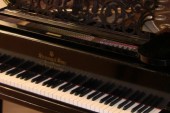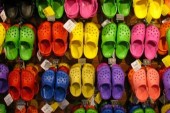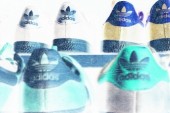
Remember when you’d visit video stores with your parents, usually to rent The Little Mermaid for the umpteenth time, and you weren’t permitted to go into the curtained off area in the back? The impenetrable black curtain acting like your own personal Berlin Wall drove you crazy with curiousity. Of course, by the time you were old enough to visit the adults-only section you’d learned all that was back there was porno and sad, creepy men– and the Internet was already cluttered with both things (if that’s your idea of a good time). Future generations will know nothing of video stores’ porno sections (or video stores, for that matter) but, hey, times change.
I remembered that curtain when I arrived at the Christian Louboutin exhibit at the Design Exchange yesterday afternoon. At the front desk a little sign informed visitors a section of the exhibition titled “Fetish” wasn’t appropriate for all ages, but it was clearly marked and curtained off anyhow.
“Goodie!” I thought. “My legs creak and I don’t understand dubstep, but at least as a grown up I’m finally allowed behind the black curtain!”
The exhibition is the first retrospective of Louboutin’s 20-year career and features over 250 pairs of his creations alongside notes and sketches from the designer’s archive. Born in Paris in 1964, the youngest child in a household of sisters, young Christian looked and felt so different from his family that he asked his mother if he was adopted. During a childhood visit to Museum of Oceanic and African Art, Louboutin noticed a sign showing a high heel crossed out with a red line. It was intended as a warning to not approach the parapet in unsuitable footwear, but young Christian took the opposite lesson–pain is beauty, danger is sexy. “You’re abandoning a lot of ideas when you are too into comfort,” he told The New Yorker in 2011.
Curator Donna Loveday, of London’s Design Museum, took inspiration from this museum anecdote and combined it with Louboutin’s love of circuses, showgirls (as a teen he worked at the Folies Bergere, where one of his jobs was to buy veal Carpaccio to slip in the performers’ shoes), and horticulture, creating a dream-like space of Broadway stage lights and Film Noir shadows. The first thing a visitor sees is a carousel-type structure from which Louboutin’s shoes rest on hanging mats that rotate gently. An avid traveller, the designer samples the cultures of the world freely–on the first installation alone his shoes featured Mexican beads, African masks, and Chinese symbols. A “Zulu” stiletto was made from faux zebra skin (at least, I hope it was faux), while a high-heeled boot covered in shaggy fur was named “Yeti.”
Fewer shoes than you might expect featured the red soles that have become Louboutin’s signature. The motif dates back to his second year in business when, to make an Andy Warhol-inspired shoe more colourful, he grabbed a bottle of nail polish and painted the bottom. Red soles on dark coloured heels were an ingenious way to differentiate his product, but knockoffs soon followed. For a time there was even an online company that sold red sole stickers so you could make any pair of shoes look like Louboutin’s.
The designer attempted to trademark the colour red for soles as Tiffany & Co. did for robin’s egg blue on boxes. After initial setbacks (one judge said, “Louboutin’s claim would cast a red cloud over the whole industry, cramping what other designers do, while allowing Louboutin to paint with a full palette”), a court last year ruled Louboutin could retain exclusive rights to use the colour red for shoes’ soles so long as the rest of the shoe wasn’t also red.
I approached the curtained off “Fetish” section, dedicated to Louboutin’s 2007 collaboration with fetishtic director David Lynch, with no small amount of expectation, especially when I heard random noises coming from back there. Adding to the exhibit’s soundtrack of circus music you could clearly hear some sort of machinery and gruff men’s voices–“Keep going! Keep going! Two more inches…” My mind filled with twisted Lynchean visions of what could be going on behind the curtain.
Sadly, once I entered I figured out the mechanical noises and men’s voices were coming from the neighbouring gallery, where workmen must have been installing something. The exhibit consisted of extreme, S&M-inspired footwear that looked impossible to wear (even for Louboutin) accompanied by photographs of semi-nude French cabaret performers attempting to do so anyway. The standout for me was a pair of “Siamese” shoes–black high heels fused back-to-back.
Over the years, Louboutin has designed shoes that increasingly embraced nakedness. “For him,” a panel states, “a successful shoe is one that preserves and accentuates nudity leaving the foot as the object of desire.” That’s fine, but with less material there’s less to look at in a gallery setting. I think Louboutin himself would agree that you don’t truly understand a shoe until you see it worn.
In many ways the exhibit’s next section, a recreation of Louboutin’s packrat atelier, was much more fun and insightful about the designer’s personality. In front of photographs of the crowded atelier, where the diminutive designer manages to practice trapeze, were Christian Louboutin dolls in cat suits, Day of the Dead skeletons in feather boas, and a pair of sequined pumps he designed for his “personal friend” Miss Piggy. The designer fills his space with souvenirs from his travels–Egyptian obelisks, wooden doors from Mexico, Indian movie posters. Louboutin’s collection of knick-knacks and bric-a-brac directly influence his designs.
I began to see Louboutin’s collection (of shoes and everything else) as a modern day cabinet of curiosities, the Renaissance custom by which wealthy Europeans presented natural and anthropological artifacts behind glass. In their Euro-centric way, these men meant their collections as a way to better understand the world and were early precursors to museums, circuses, and freak shows. Fashion, with its freewheeling attitude towards cultural inspirations may be the cabinet of curiosities’ last gasp. But with more and more people speaking up and questioning cultural appropriation, the days of glamorous “Zulu” shoes have run their course.
____
Max Mosher writes about style for Toronto Standard. You can follow him on Twitter at @max_mosher_.
For more, follow us on Twitter @TorontoStandard or subscribe to our newsletter.














